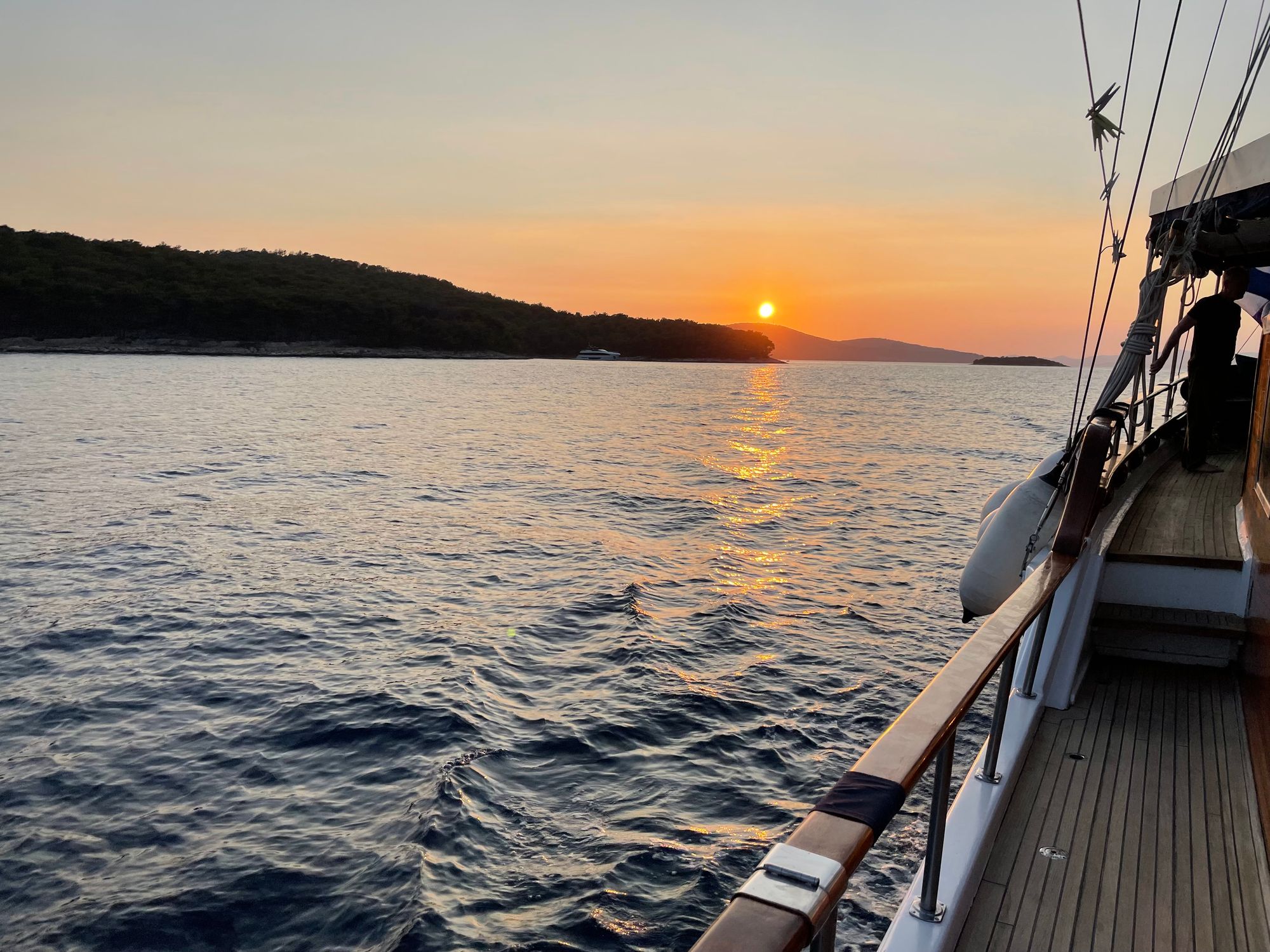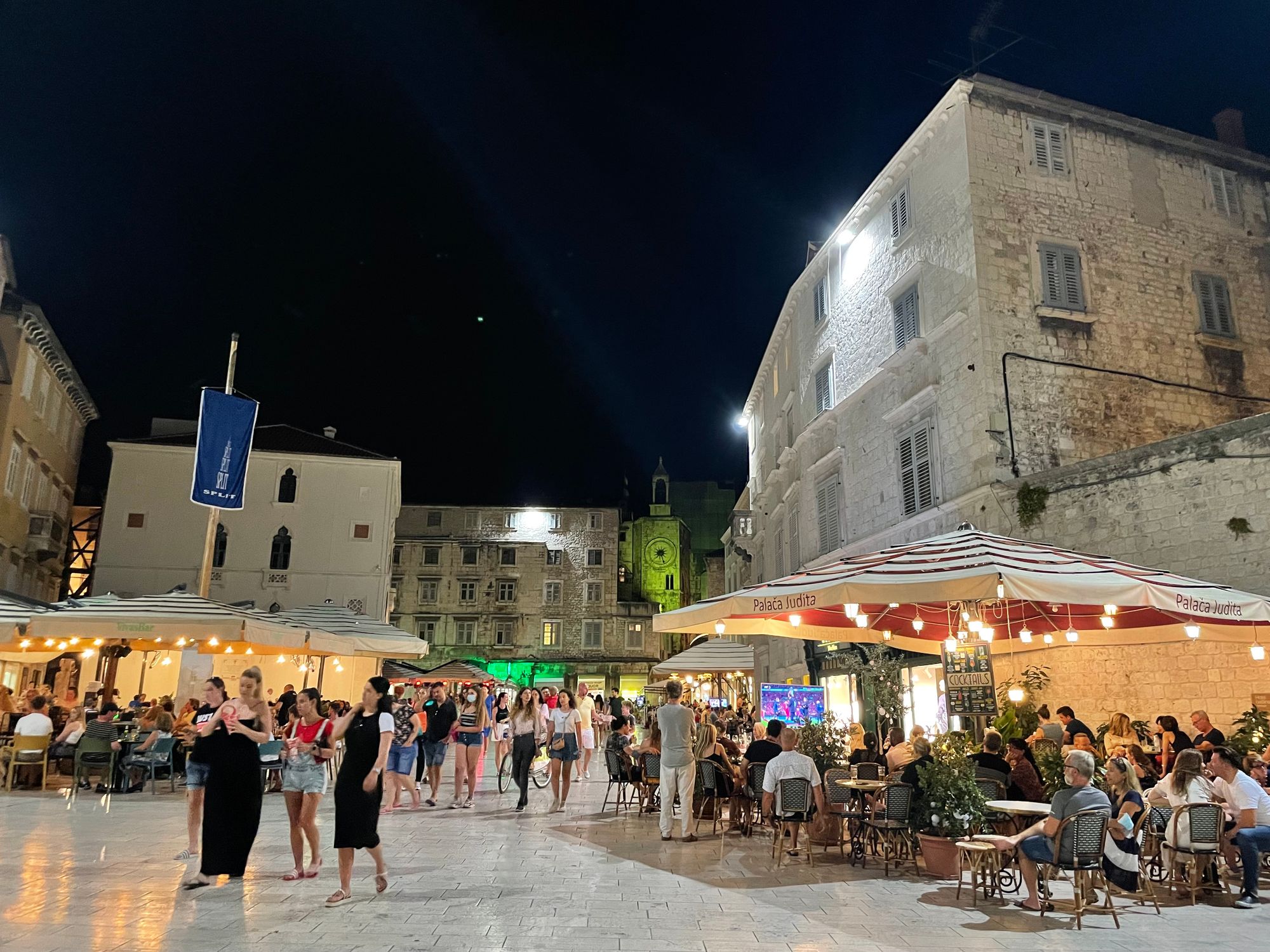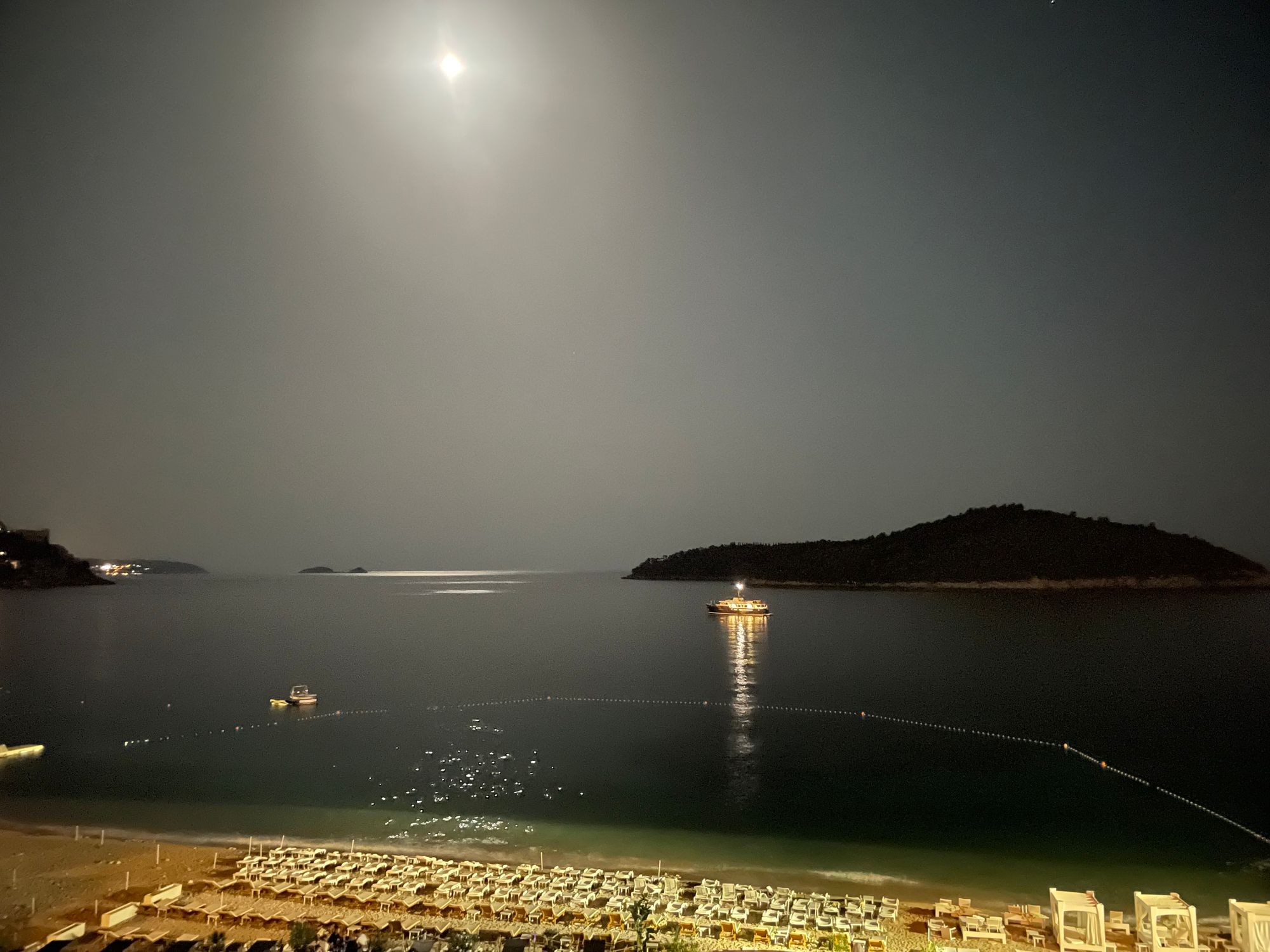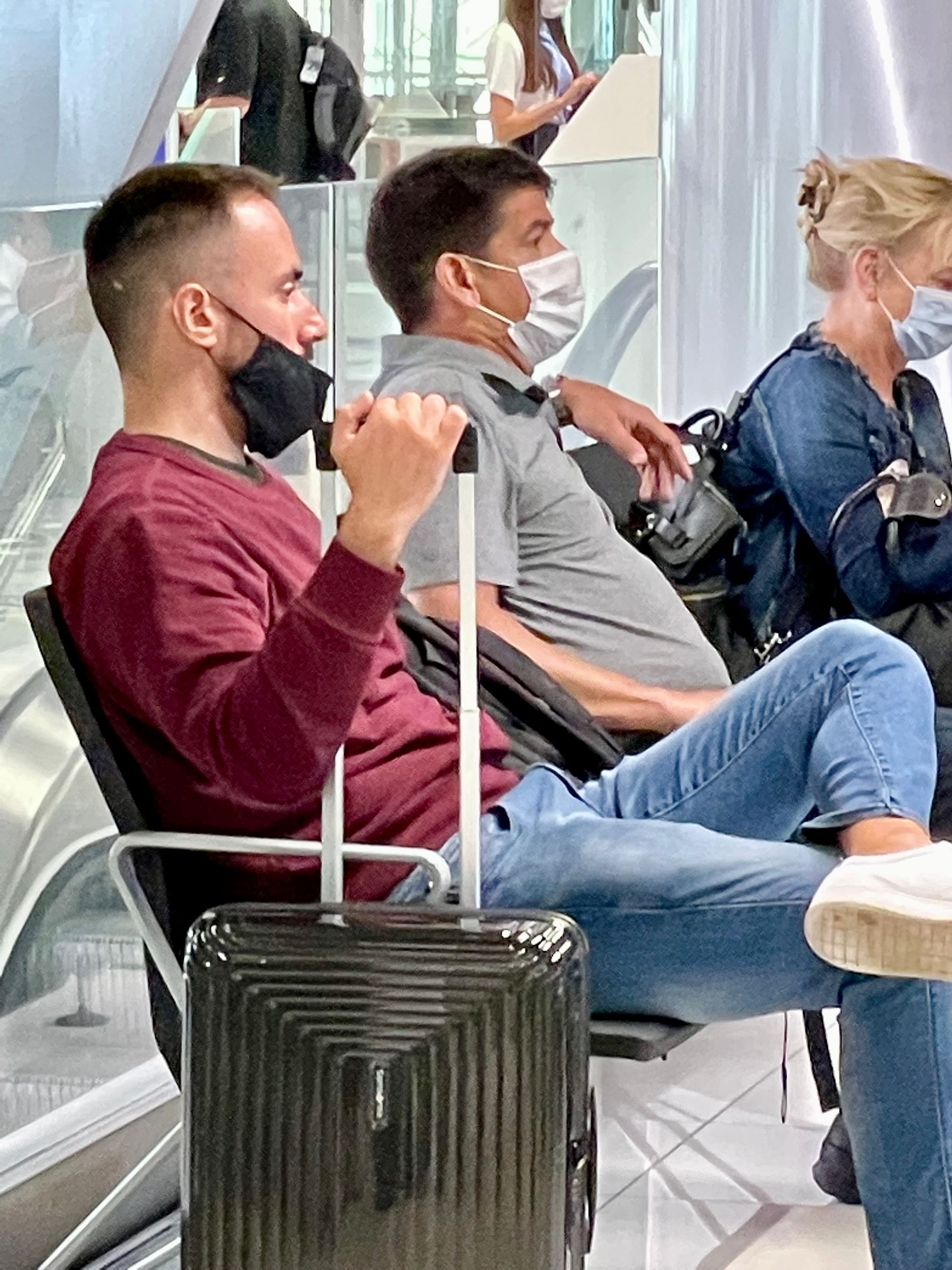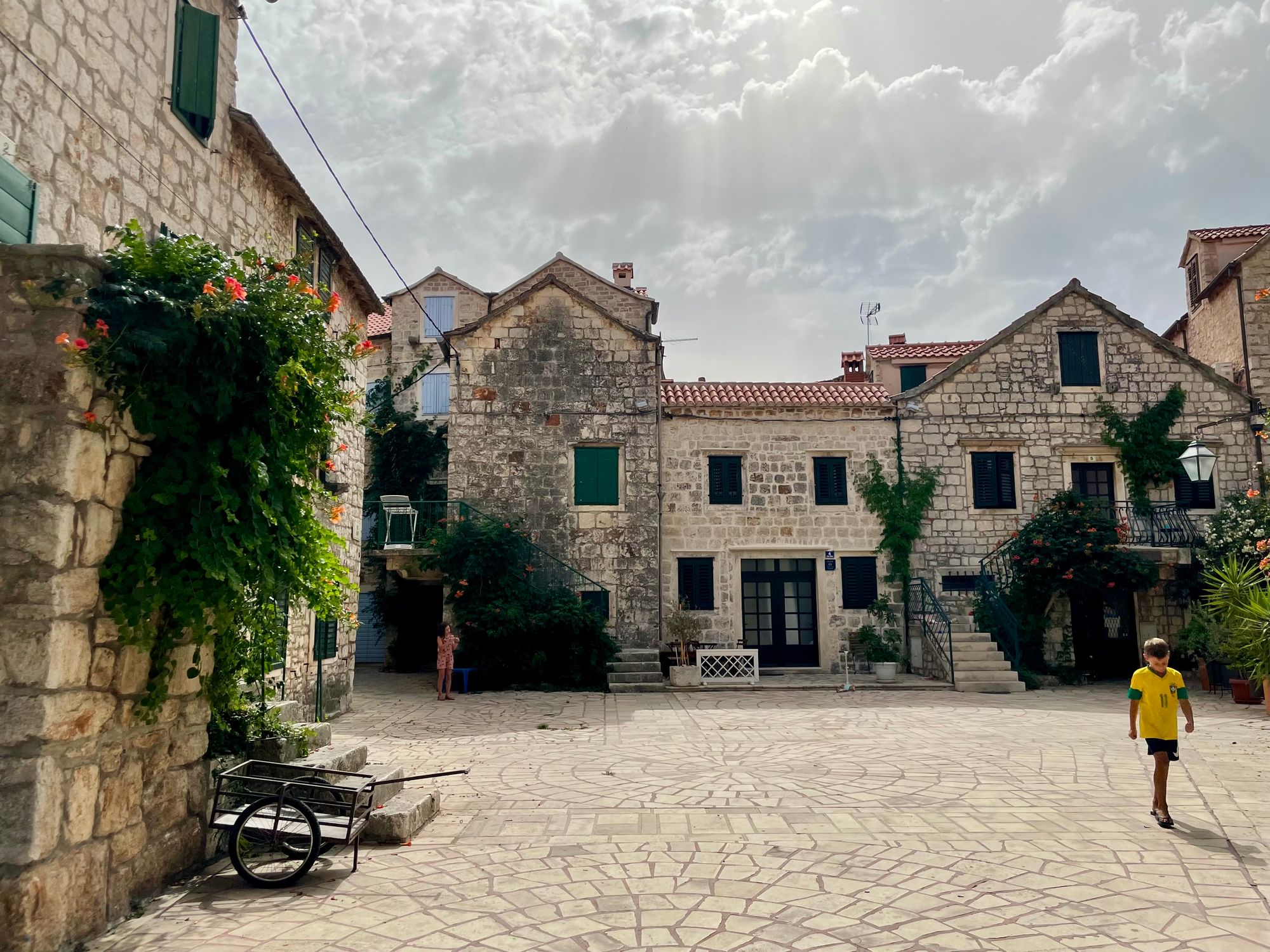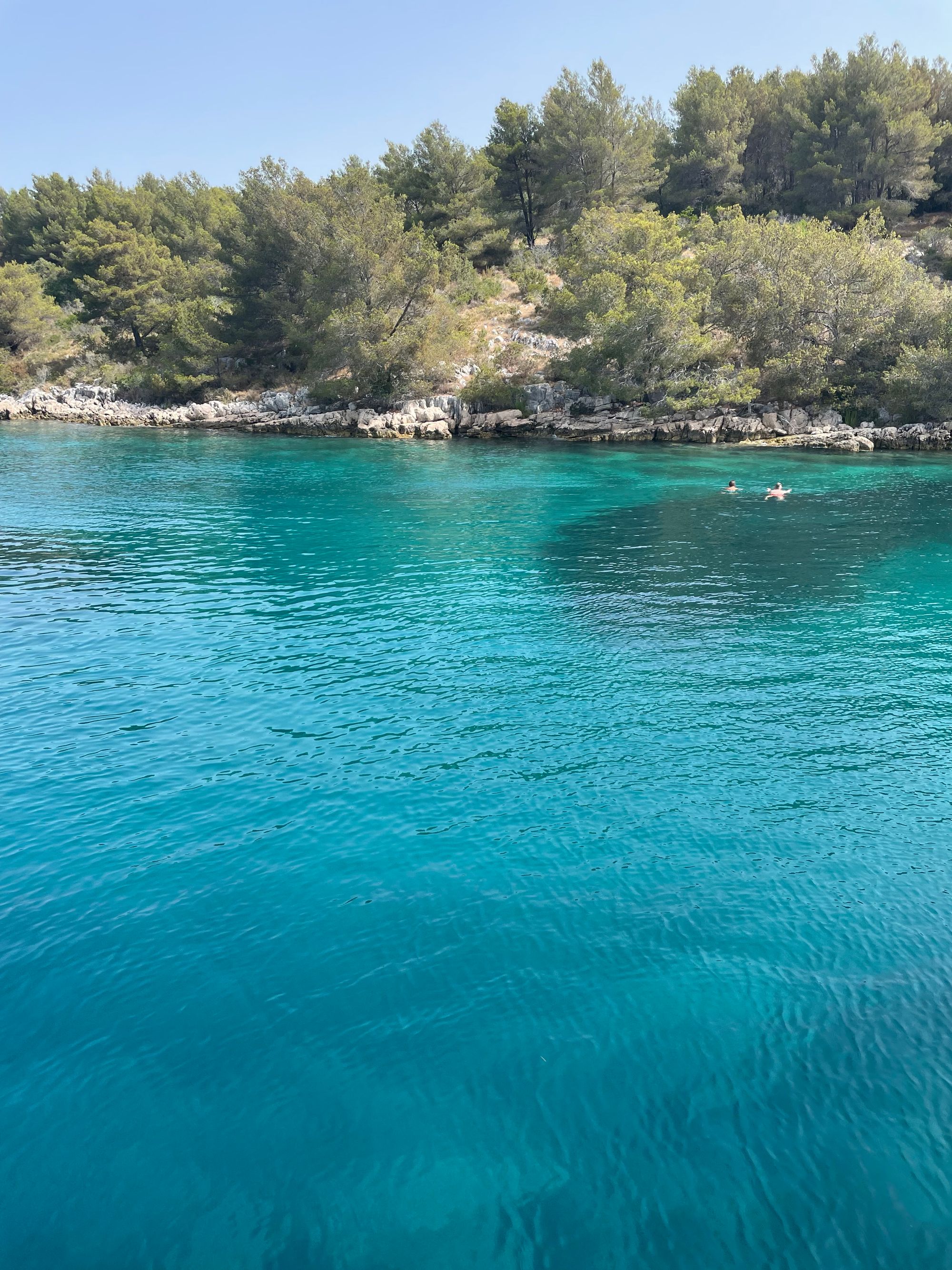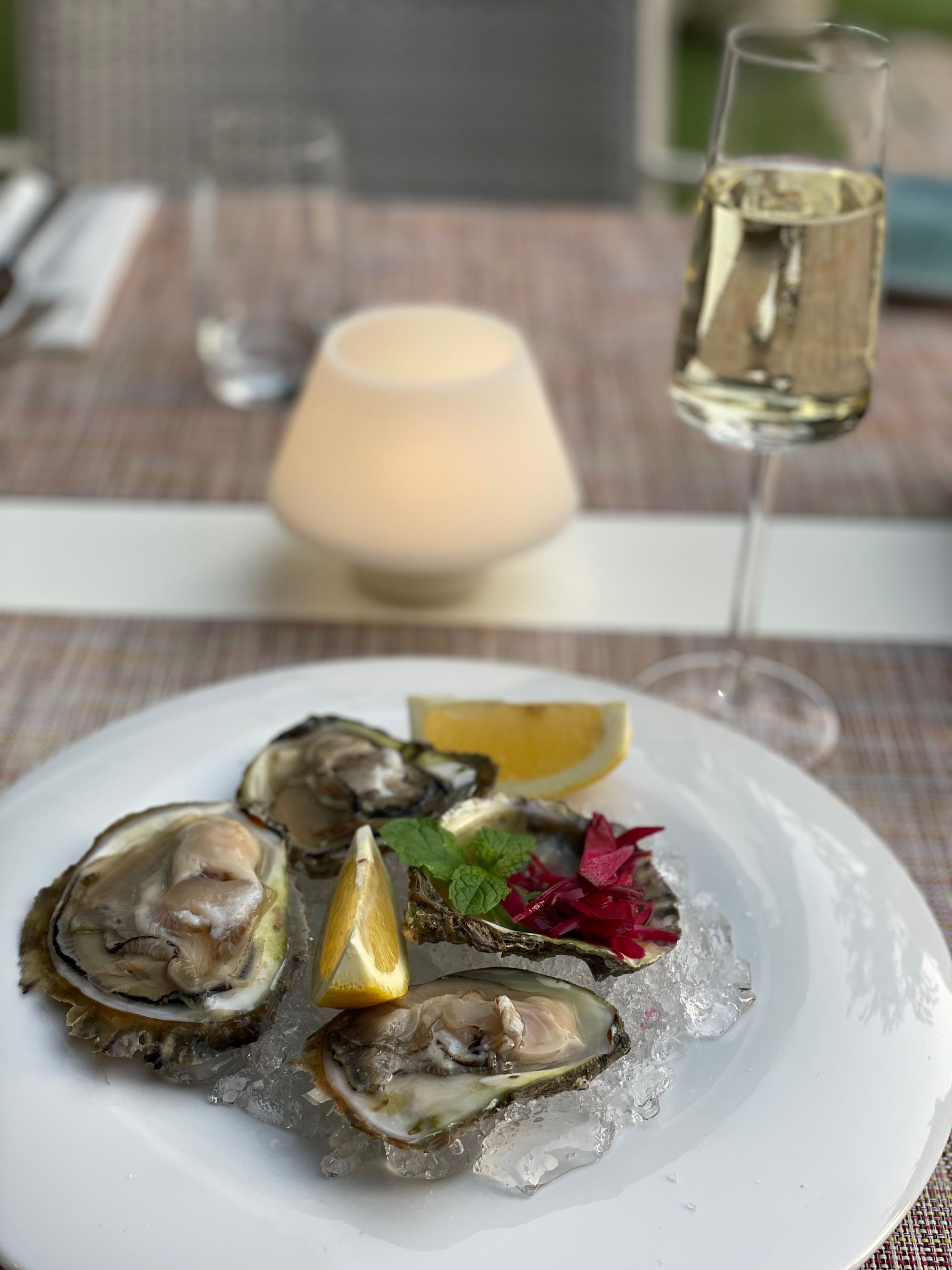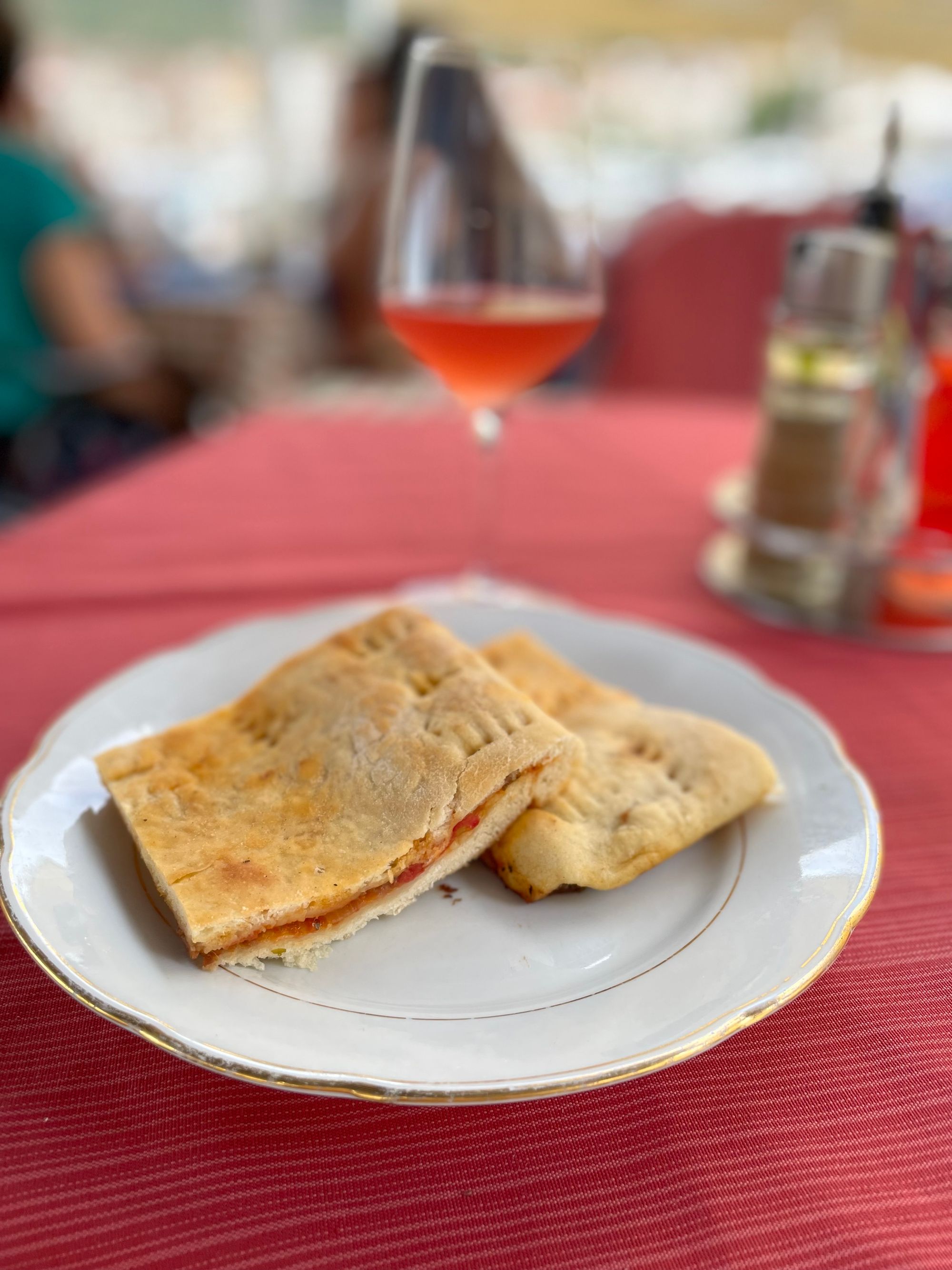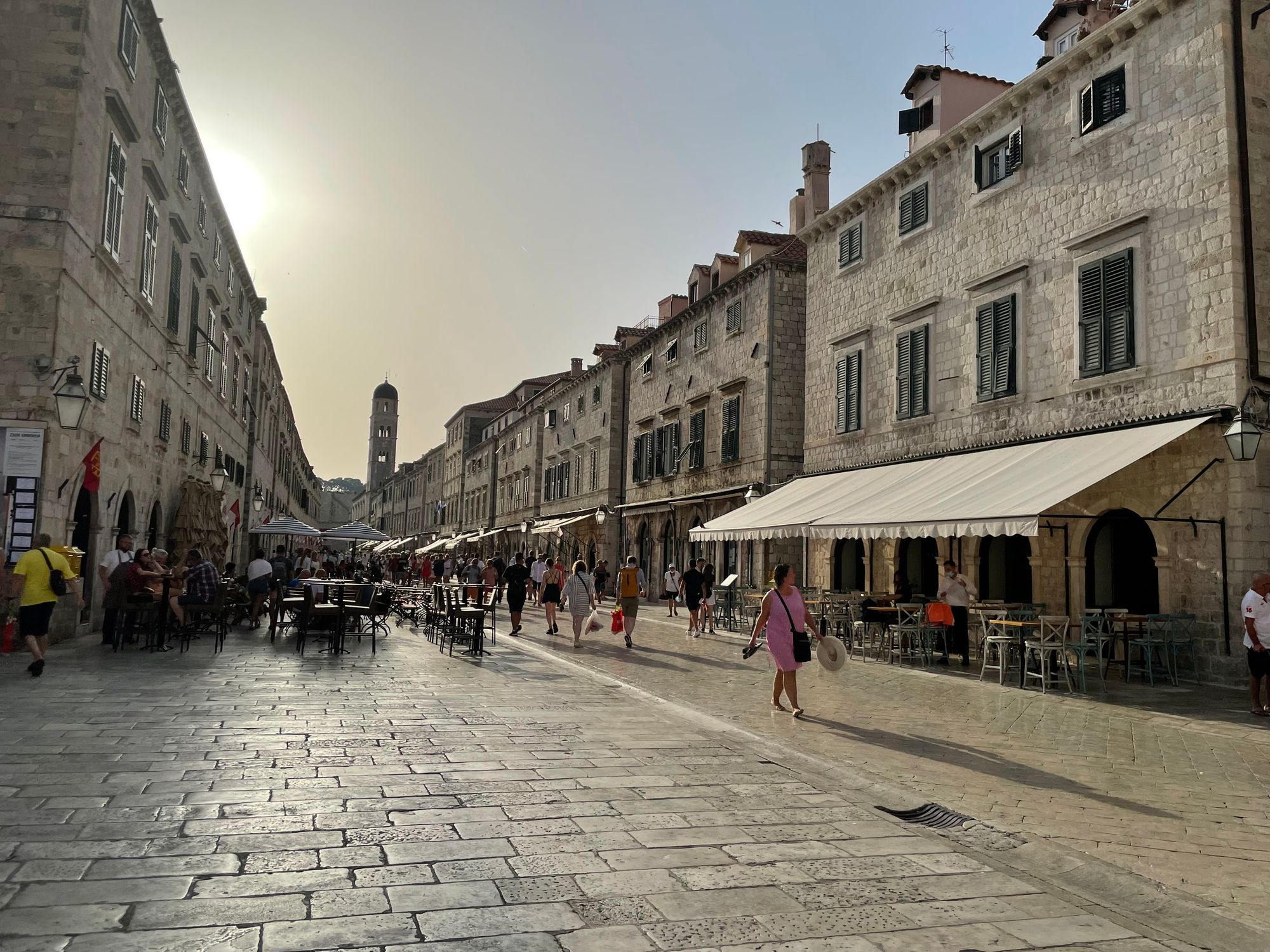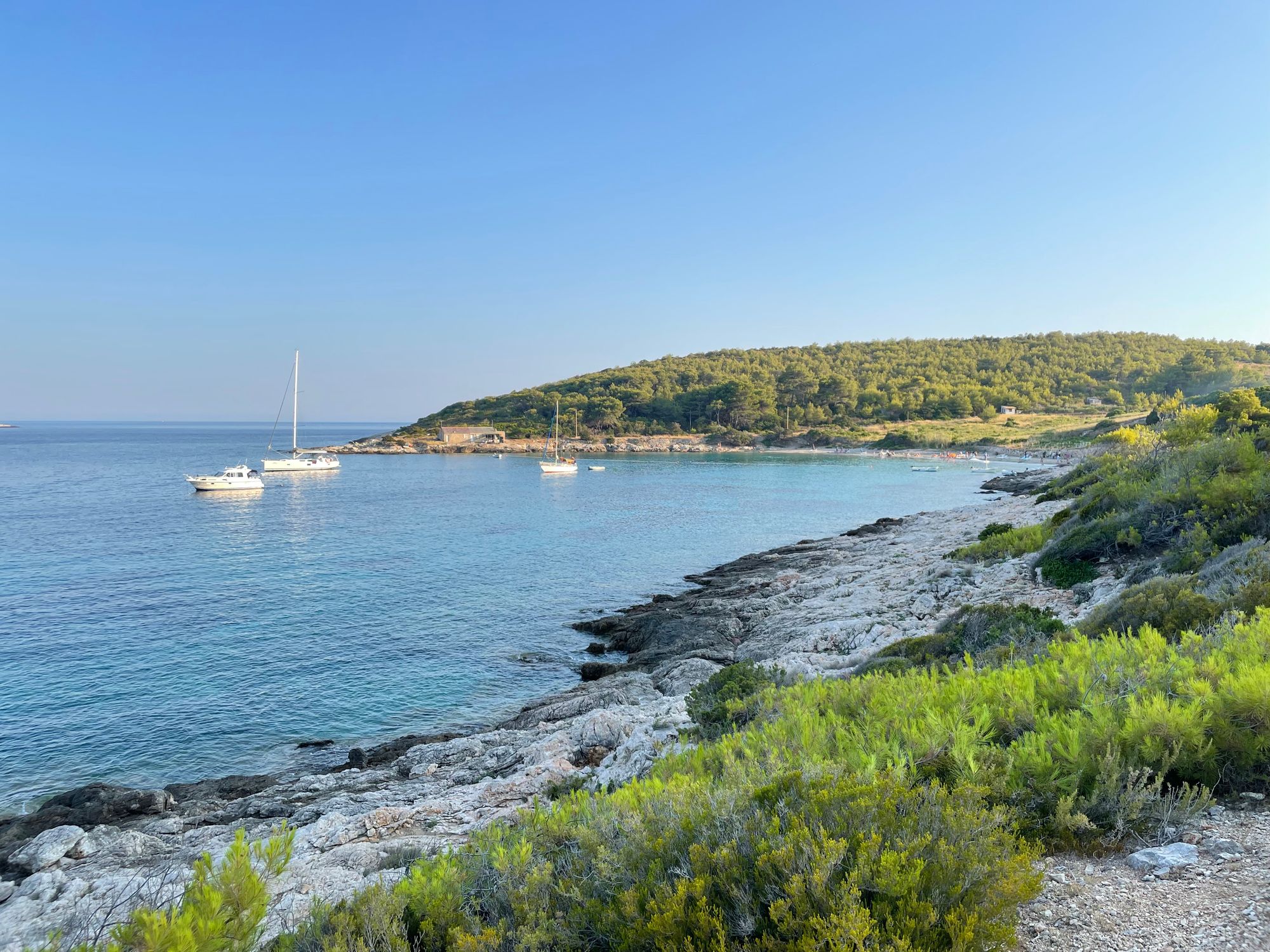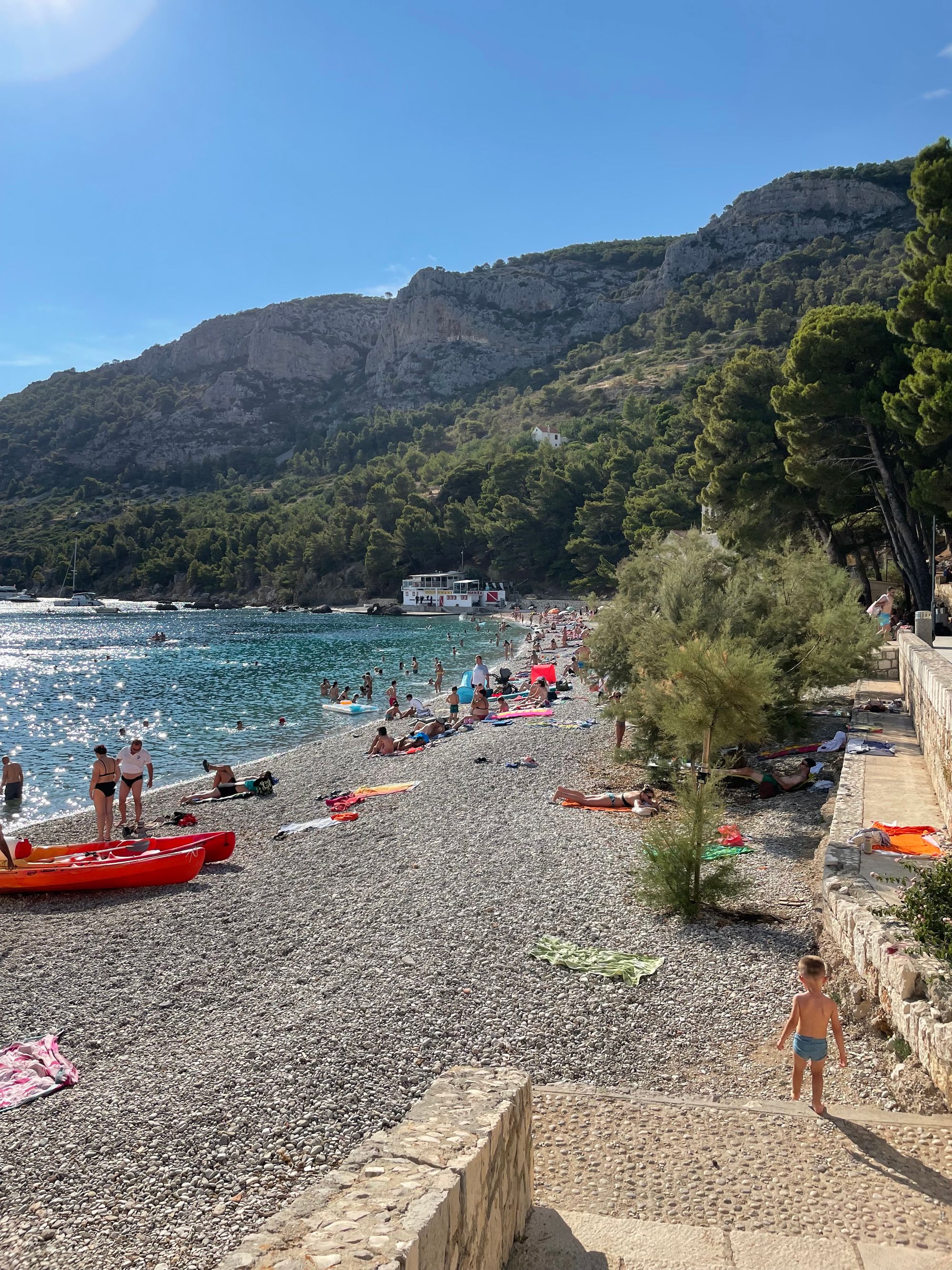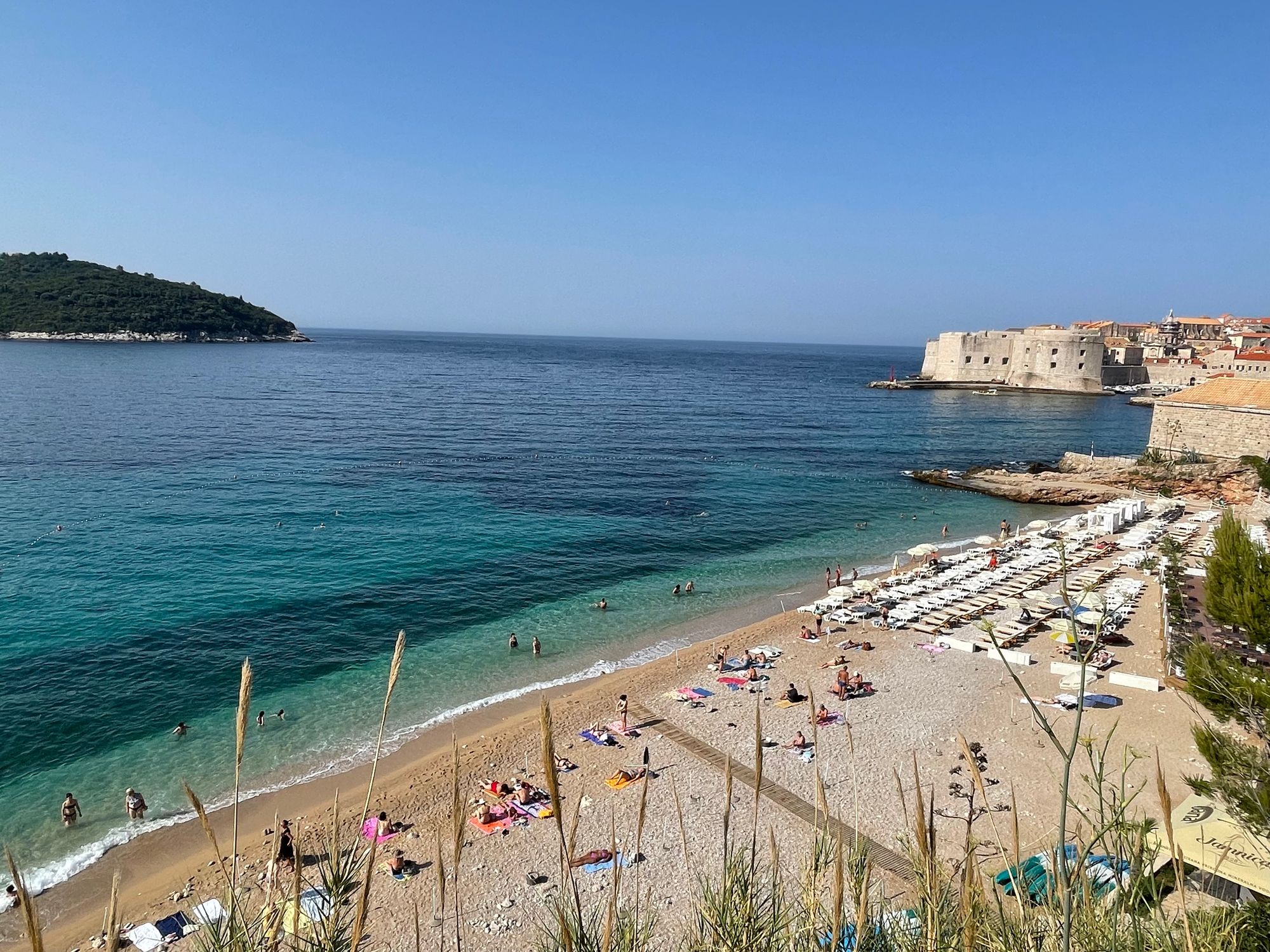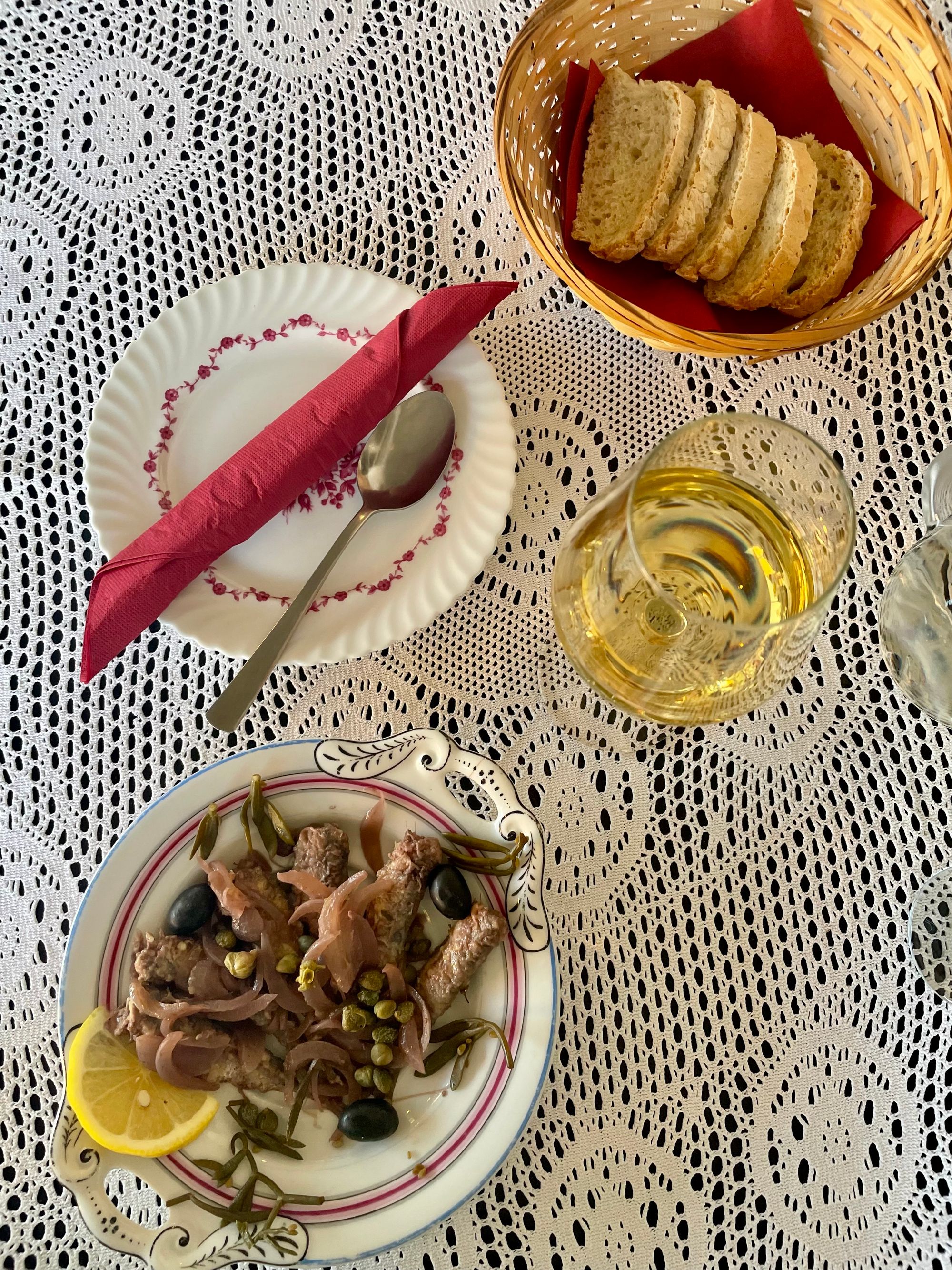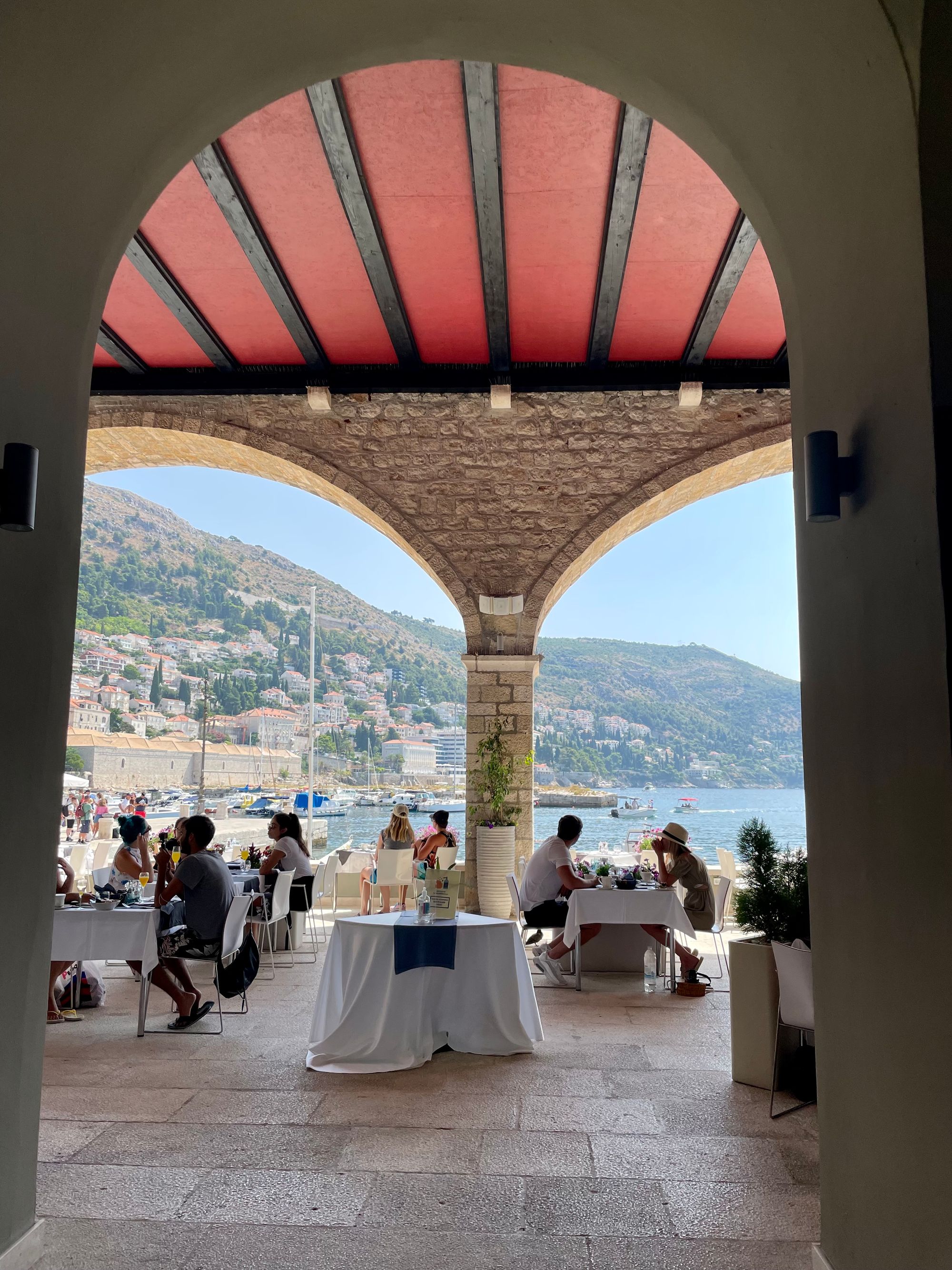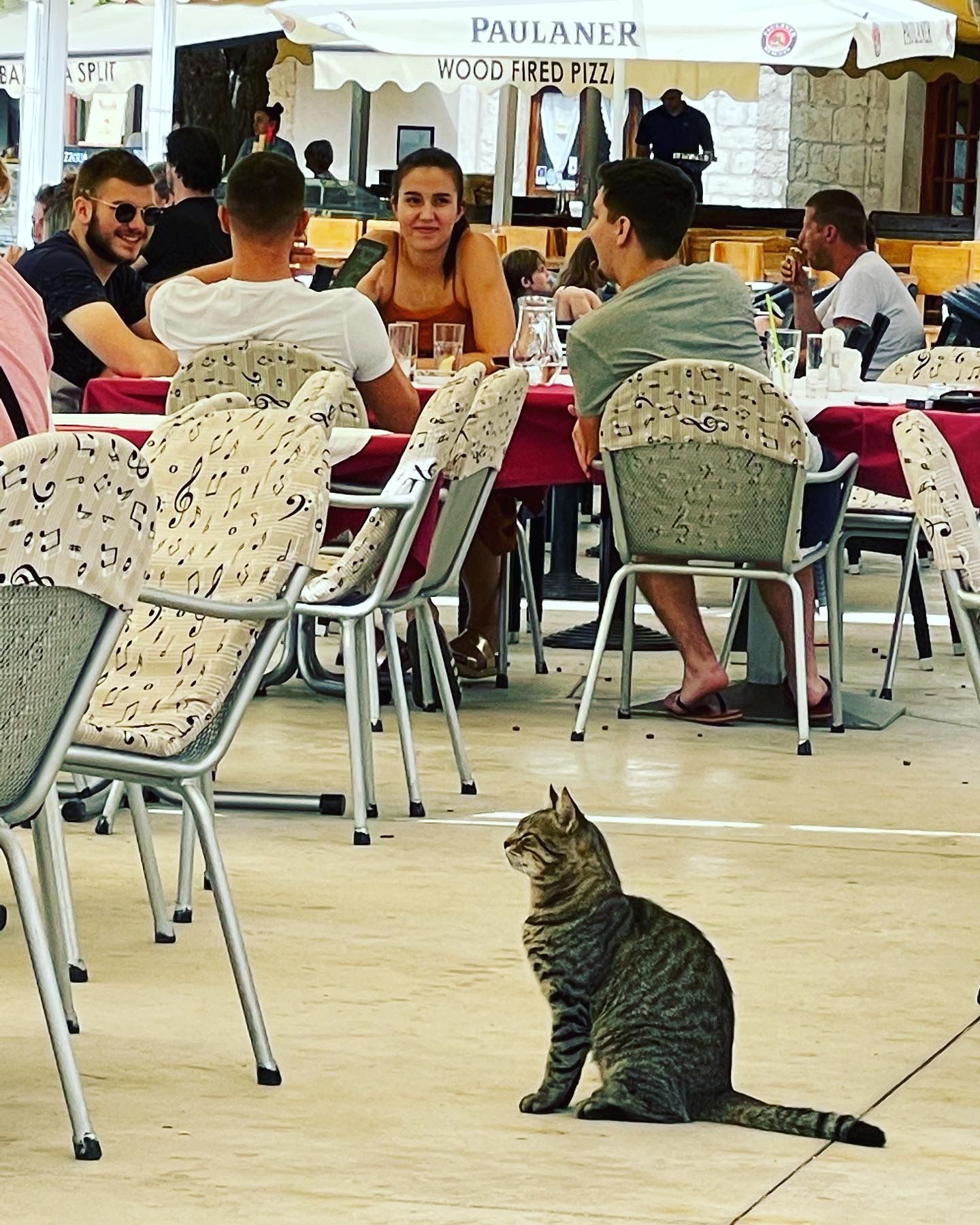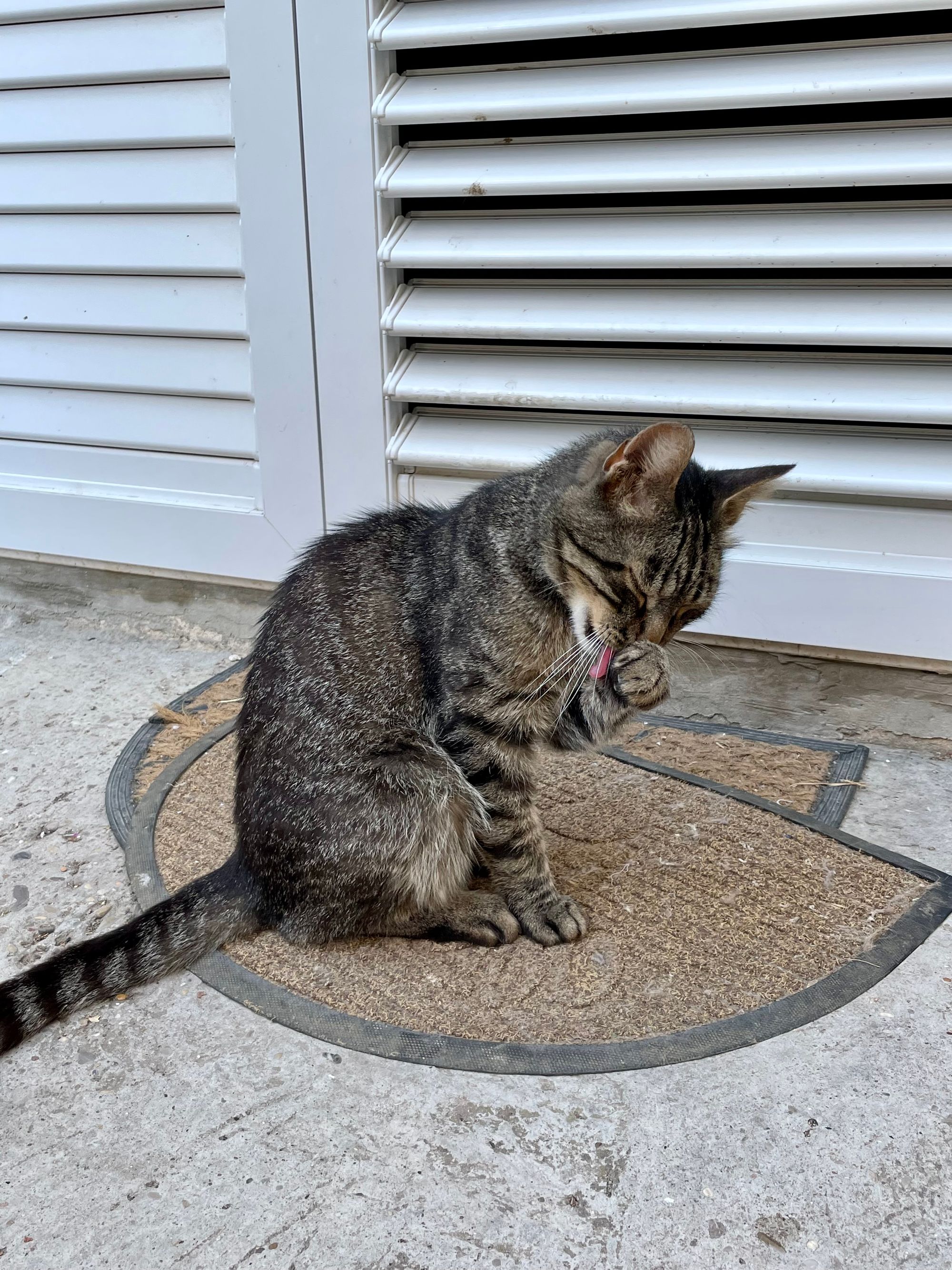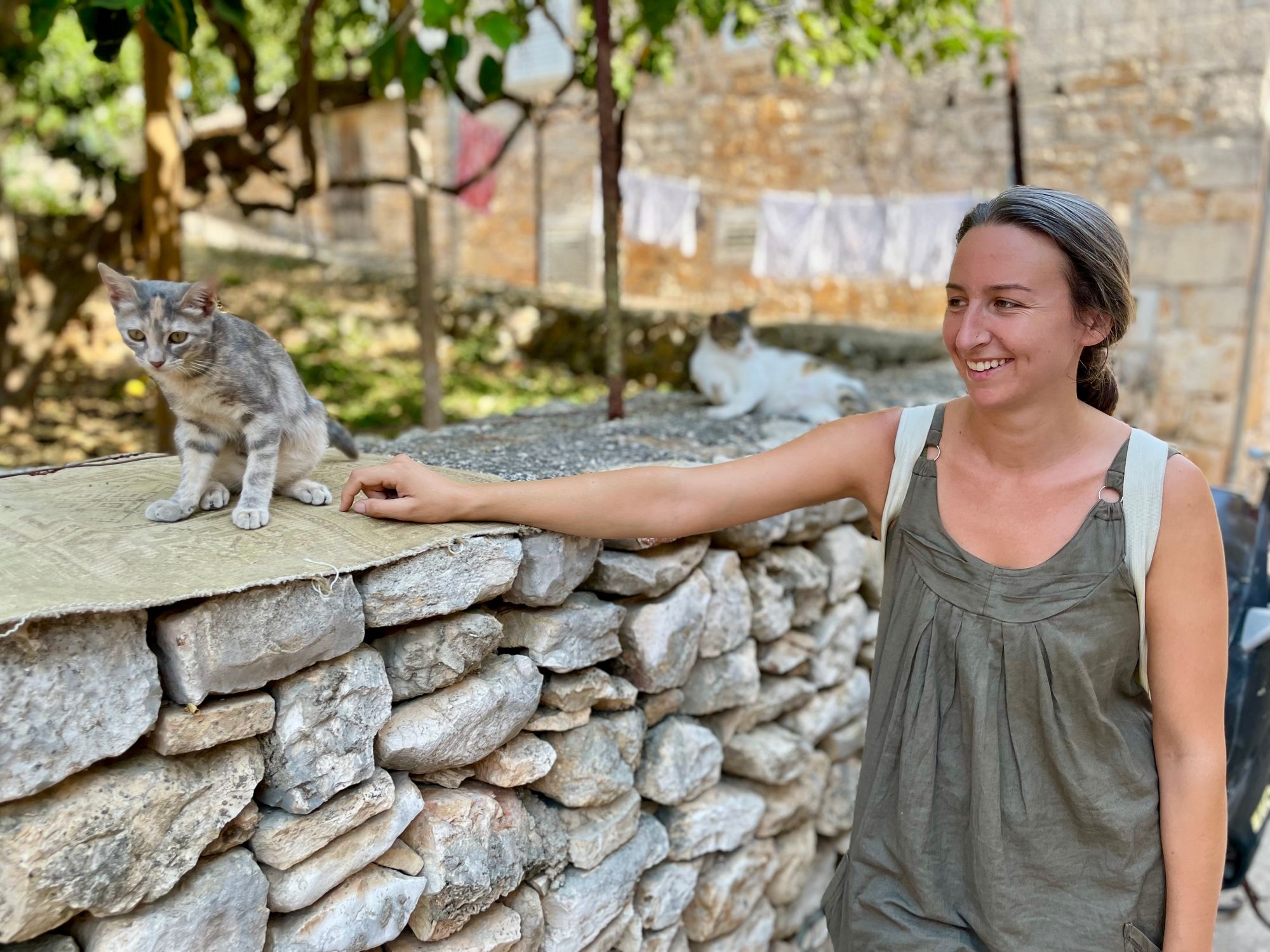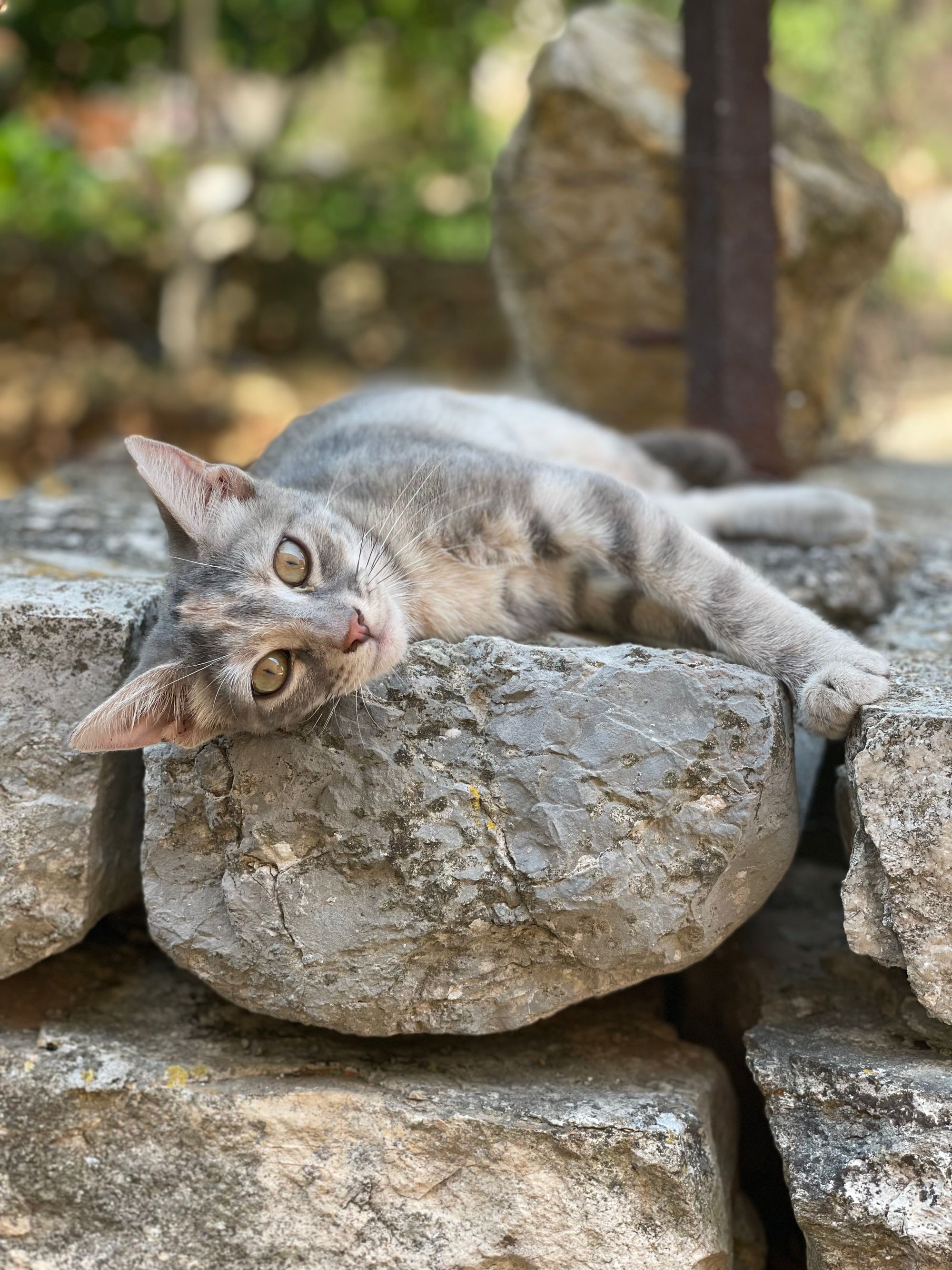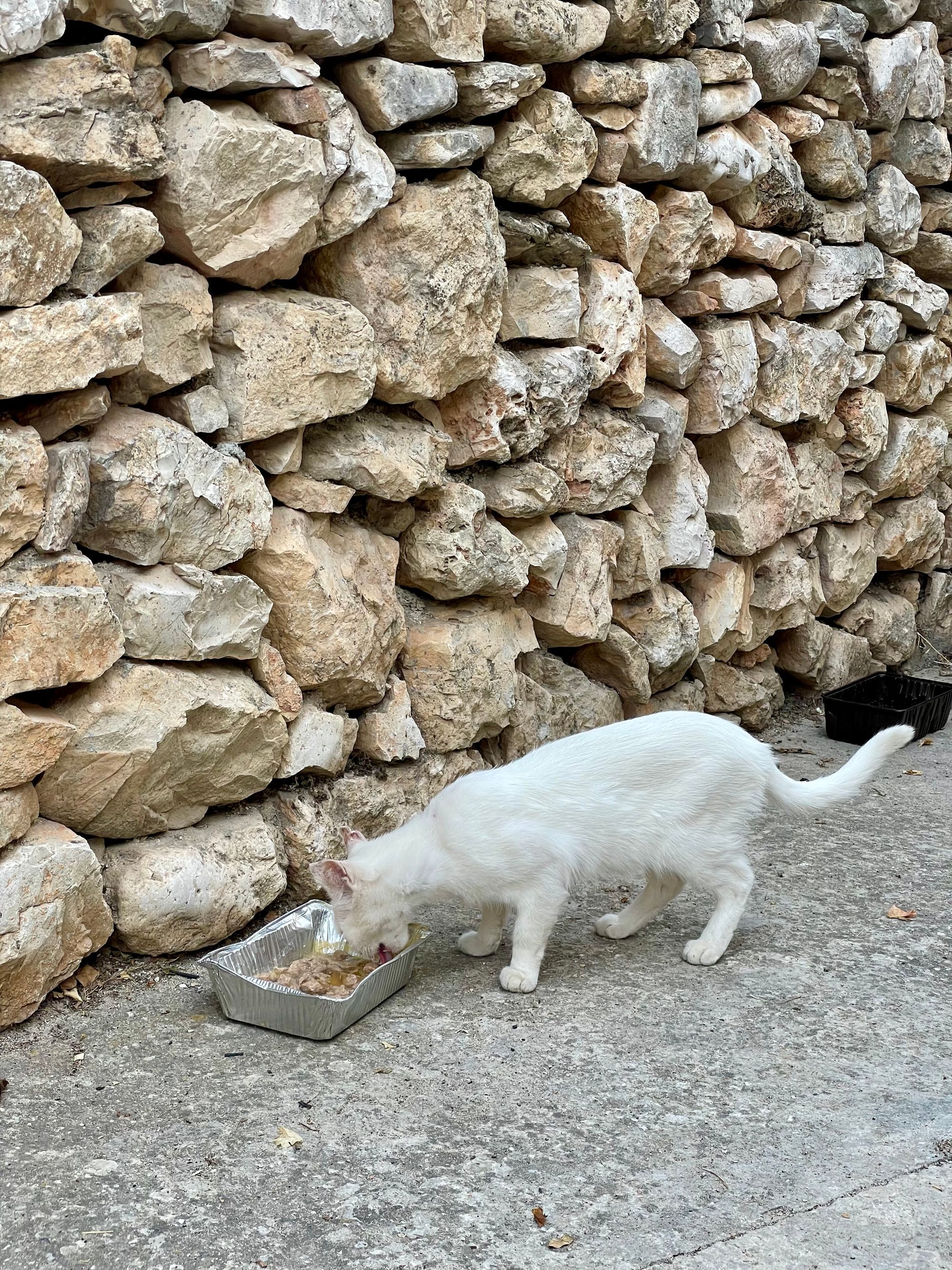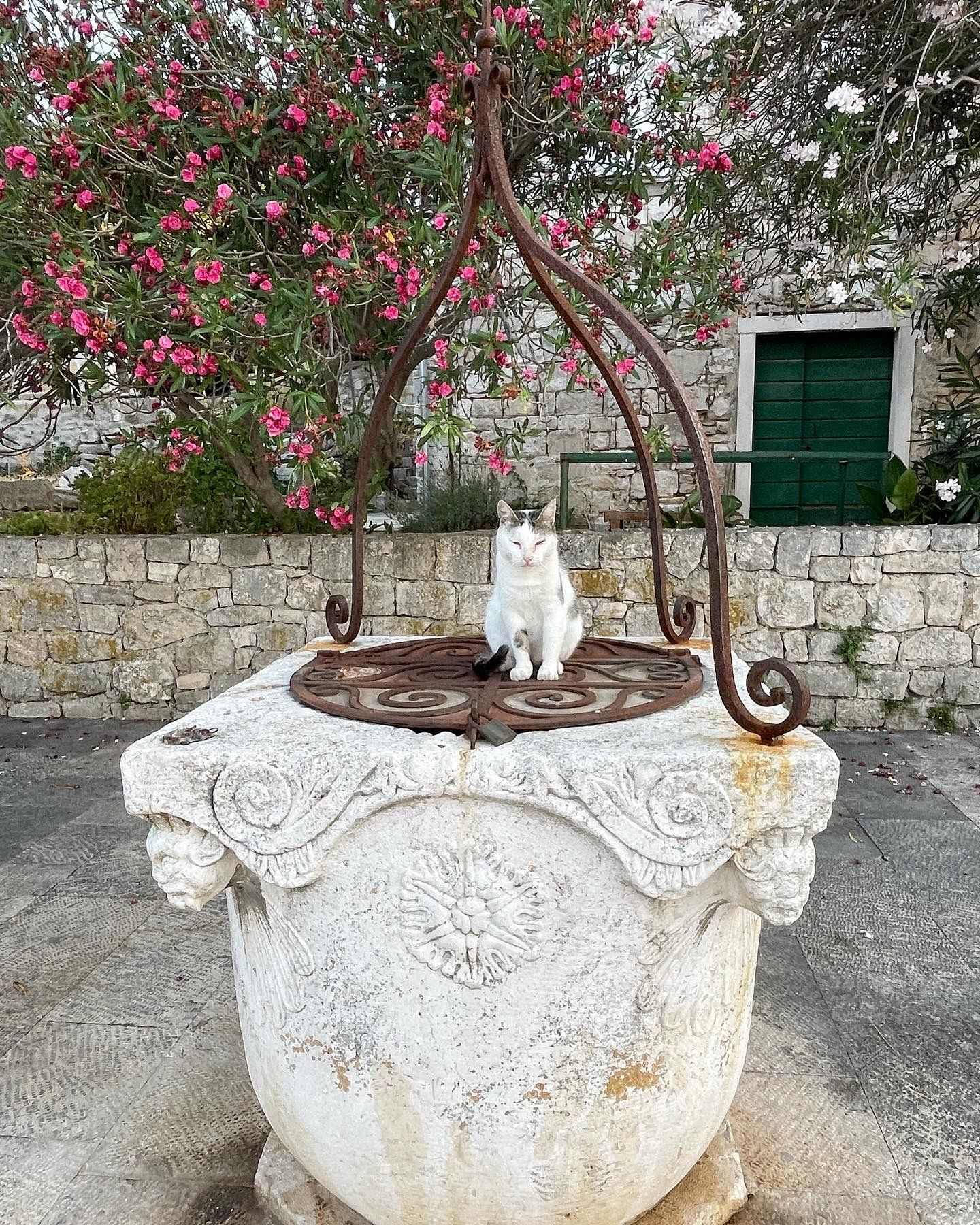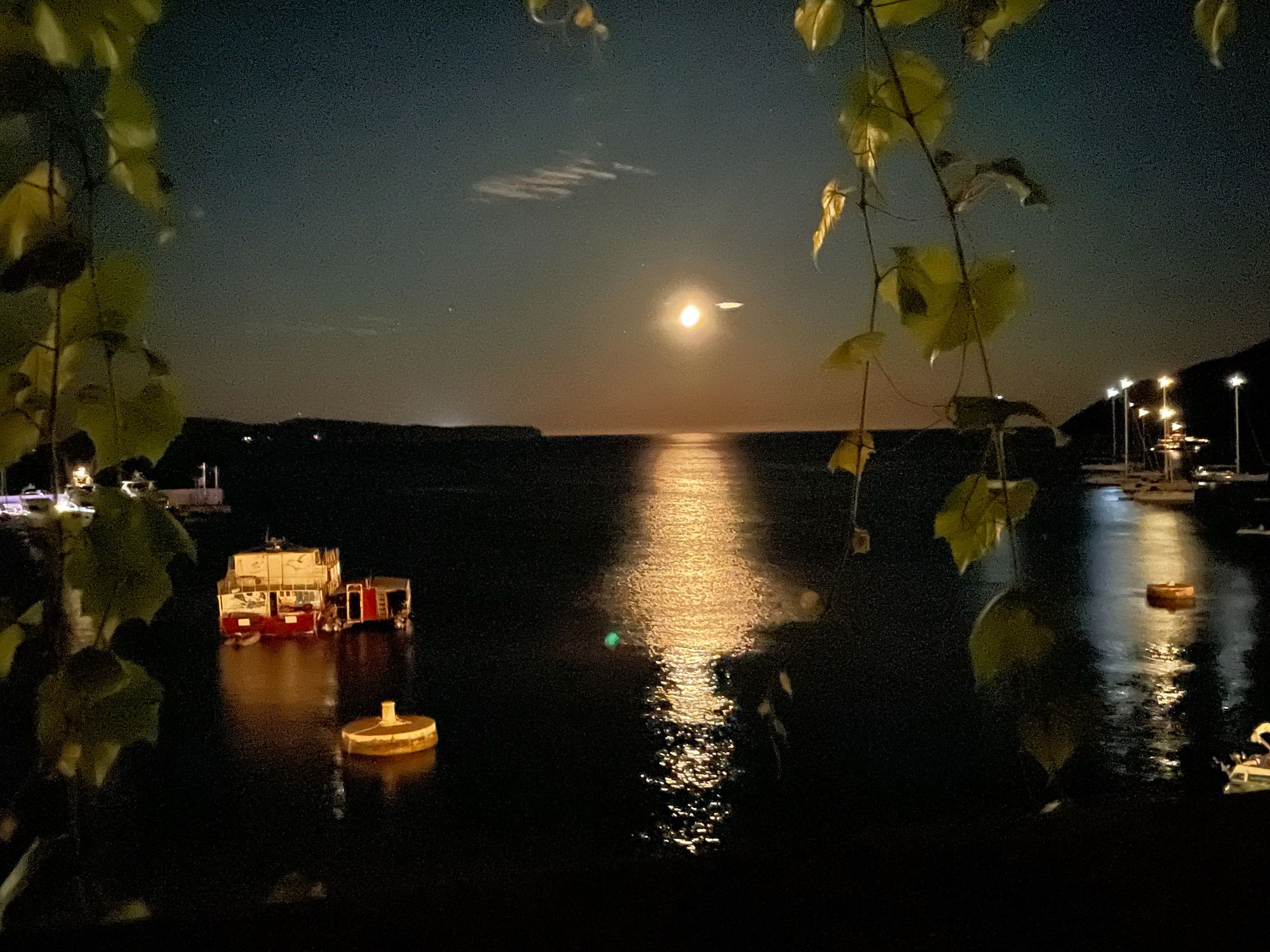Croatia—a place that has been calling me for years. Thanks to my dear friend from college (my first gay friend who lived next door to me in the dorms during our freshman year at UCLA) who invited me to join his big birthday celebration on a gulet (a classic, Turkish, wooden, sailing yacht), I was finally going! He chartered the Perla for a week to tour the Dalmatian islands in mid-July (whut). Talk about a dream trip! Someone pinch me.
At the end of May 2021, Croatia became one of the first countries in Europe to welcome vaccinated American tourists. Since I was going to be spending all of my United miles on the trip, and haven’t been able to travel in almost two years, I decided to bookend the gulet trip with at least a few more weeks exploring the country on my own.
For the first time in my life, I only booked a one-way ticket—I didn’t want to commit to a return ticket date just yet. Partially because I was traveling in a pandemic, and wasn’t sure how things were going to go. I also didn’t have much of an itinerary, just ideas, and didn’t know which city I was going to want to fly home from.
Traveling during a pandemic was complex, at times challenging, and emotional, too. I know many folks are assessing whether or not to travel right now. I feel like I managed to slip through a small window with this trip: it was before the Delta variant was really getting a stronghold and we started seeing breakthrough infections with vaxxed folks. When I flew to Croatia, I felt rather invincible. I was vaxxed and ready to relax, meet people, eat in restaurants, go to bars, and do happy tourist things. I couldn’t believe I was actually traveling again, to such a beautiful place, so far away from home. A summer fantasy.
After five days in Split and a truly epic, glamorous week on the gulet (caftans and caviar night, wig night, 80s night!), I got blindsided with the news I have been dreading this entire pandemic: my parents contracted Covid back at home. Yes, they’re fully vaccinated (Pfizer); no, we don’t know where they got it (they live in San Mateo). I was so worried for a few days there. Thankfully, the vaccine did its job and kept their symptoms to a minimum, although my Mom was massively fatigued and still doesn’t completely have her smell and taste back. We’re at six weeks later and her smell and taste are barely at 40 percent. But, it’s infinitely better than being hospitalized—so big thanks, science, for diminishing one of the greatest fears of my life: losing my parents to this horrific virus, a heartbreaking loss too many people have suffered.
To have my own parents contract a breakthrough infection greatly shifted my perspective about how protected I was in a country with around a 40-percent vaccination rate and a culture of IDGAF chin-masking in enclosed public spaces. My earlier sense of invincibility was replaced with shocked vulnerability. But knowing my parents dodged such a deathly bullet bolstered my resolve to keep acting like I was an ambassador for Pfizer in Croatia. I met so many Croatians who didn’t want to get vaccinated: young people, hospitality folks. There was so much distrust, fear, and misinformation. I tried my best to share facts and ask about their fears and unpack the fiction. But their history is not mine, and their government is not mine, and their experience is not mine, so I wouldn’t push too much.
Fortunately, almost everywhere I ate and all my activities were outside—I only went into grocery stores and the occasional shop masked. Uber drivers in Dubrovnik were notoriously unmasked, but I’d have mine on and keep the window wide open. A 20-minute packed bus ride on the island of Vis with closed windows and an enclosed five-hour catamaran from Split to Dubrovnik were stressful, with at least half the passengers cavalierly wearing masks under their nose or on their chin (although they were supposed to be masked). I kept my KN95 on and tried to keep my mind steady. I originally planned to hop around Croatia more, but after my parents’ diagnosis, and assessing my transportation options, I decided to stay put on the island of Vis and cool my jets.
I had to get tested before flying home, and had another test five days after my return to SF to be extra-sure. I really thought I’d be returning to “almost-normal” life when I got home. But if the past seventeen months have taught us anything, nothing is certain, and everything is subject to change. Being vaccinated offers a level of protection from dying, but doesn’t mean we still can’t get sick, as this horrifically infectious Delta variant is here to show us. Here are some recent stories of tourists who tested positive for Covid while abroad in Europe, and how they had to quarantine. If you’re going to travel right now, be sure to think about some contingency plans in case your trip home is delayed by a positive test (it’s not just time, it’s money, too), or worse: you get very sick. Contributing to the spread of Covid would weigh very heavy on my heart—tourists don’t just stay in one place, so I’d recommend you get tested before you leave the U.S. Everyone has different risk tolerance levels, but mine currently has me very grateful to be home safe and back in control of my exposure choices.
Okay, now that my pandemic preamble is complete, let’s dive in about this gorgeous country! I only toured around Dalmatia (Split, Dubrovnik, and the islands of Vis and a couple stops on Hvar, plus a day trip to Sibenik and Krka National Park) and have much more of the country I need to explore (Istrian Peninsula and Plitvice Lakes, you’re next!), but here are my impressions of the places I did visit. The thing that really stood out to me is how clean Croatia is, from the streets of Split to the beaches on Vis to the coves where we anchored the gulet. Nice job, people. The water was so clear and pristine, and even when I was snorkeling, I didn’t see much garbage on the sea floor or floating on the water. (Italy, take some notes.)
The food was equally clean: I had so much amazingly fresh and simply prepared seafood—from raw oysters from Ston to shrimp carpaccio to octopus salad to grilled calamari and sardines and langoustines. All the raw seafood preparations were fantastic. You’ll also see a lot of remaining Venetian influences in dishes like squid ink risotto; brudet (AKA brodeto), a vibrant, tomato-based fish stew (I remember having it in Corfu, another place formerly part of the Venetian Republic, as well as pašticada, a beef stew full of spices and a touch of vinegar, served with pasta or dumplings that you’ll find on menus in Dalmatia—read more about the dish’s interesting roots here). A classic Adriatic preparation is buzara-style, a simple fish stew with olive oil, wine, garlic, breadcrumbs, and herbs, like parsley (so good with their black mussels and clams). Sadly, you won’t find any sea urchin on the menu—it’s illegal to fish for them since they keep the water so clean (at least that’s what I was told). Prices are quite affordable—you’ll be able to enjoy some special seafood (and more) without breaking the bank.
You’ll find all kinds of cheeses (look for cheeses from Pag, as well as cheeses with Istrian truffles), smoked prosciutto, and incredible olive oils from Istria. Croatian breads were notably good, with so many variations, from ciabatta-like breads with olives to bread with corn to sourdough.
A special shout-out to Croatia for their potatoes—I think they’re the best I’ve ever tasted. Every time I ate them, I was like, damn, that’s a good potato! If you see krompir on the menu, get it—it’s a potato and onion dish that totally rocks. Dalmatians also serve a side dish you’ll see everywhere called mangold, made of Swiss chard and potatoes. I started carrying hot sauce in my bag (swag) to give it a little zhoosh—it was usually pretty plain, even with some spicy olive oil poured over the top. Which reminds me—most restaurants have olive oil and vinegar on the table, but you should ask and see if they have any other special kinds of olive oil (sometimes they’d have some good stuff from their farmer friend stashed behind the bar).
There are bakeries everywhere, with cheese-filled burek inside golden layers of phyllo, cookies, and cakes with pastry cream or fig and carob, and if you’re in Split, look for the UNESCO-protected, chard-filled rustic flatbread called soparnik (I had some at the open-air green market on a food tour of Split). While on Vis, I ate pogača from a different place almost every day—in the town of Komiška, Komiška pogača is a type of bread pie filled with tomato, onion, and anchovies, while Vis town’s Viška pogača skips the tomato. (I love that one island with less than 4,000 inhabitants has two pogača styles.) It’s the ultimate thing to pack in your beach bag for lunch or a late-afternoon snack (since I was staying at the beach until at least 8pm every day).
The wines were fun to explore, from the many bouquets of pošip (it goes so well with seafood—look for producers Korta Karolina, Tomić, and Stina), dry and ancient grk from the island of Korčula (I liked one from Popić, and I hope to drink the absolutely fantastic grk from Bire at least once again in my lifetime), and I’d order the sparkling pet-nat from Tomac or their extra brut whenever I’d see it. Ditto bubbles from Stina. You can also taste some extraordinary orange wines (look for Aurum pošip from Divina, or rajinski rizling from Vina Kos). I can’t drink red wine anymore (I get two-day migraines from hell), so, sorry, no recos there. The local wines were incredibly affordable, I’m talking $6-$8 a glass, even at some bougie places, so drink up and try everything. I’m looking forward to tracking down some Croatian wines here…fortunately, Topochines imports some of the ones I enjoyed.
Sadly, espresso was honestly quite terrible almost everywhere I went. There are a few quality coffee bars you can visit in Split or Dubrovnik for a good pull, but otherwise I ended up switching to Turkish coffee when it was available, or iced lattes. It was rough! You’ll also want to have a discerning eye for ice cream—you’ll see it everywhere, but a lot of it is super-sugary and covered in syrups and candy. Blergh. I’d have to hunt for the more artisanal and naturally flavored gelato, but it was so worth it.
Being in Croatia in July was a shock to my SF-adjusted body: I went from 60 and misty in SF to 96 and blazing, intensely bright sun in Split and Dubrovnik. Your feet will swell, you will sweat (although it wasn’t very humid), and all I wanted to wear were my linen dresses, midi caftans, sandals, and sun hat. Things cooled off a bit out on the islands—Vis was a dreamy 80-something every day, with warm evenings in the mid-70s.
Most of the places I went to had old towns, with narrow streets and no cars allowed, which is an ideal way to explore a city (unless you’re staying in a hotel in old town and you have a heavy bag with a busted wheel). You will wander through many winding streets that reminded me of Venice. Go ahead, get lost.
So, I am a complete and total beach bum. Swimming in the Mediterranean is my absolute happy place, and it was not an accident that I was in the water every single day of this trip. That was the plan! The Adriatic is the perfect level of salty, so you can float and bob around on the water with ease—I’d practically take a nap out there. The beaches can be spectacular—the water comes in the most stunning array of turquoise blues, and is so gloriously refreshing. I’m glad I bought a swimming mask, I got a lot of enjoyment out of it—the water is so clear.
Most beaches are rocky/pebbly—you’ll want to wear dorky water shoes, which also protect you from the sea urchins that tend to hang out at the rocky beaches. I noted locals brought thick beach pads to put their towel on, brilliant—I wish I had bought one early on in my trip. (You’ll find beachwear shops and stands everywhere.) I did find some sandy beaches on Vis, but that usually means more people and kids. The beaches are full of children everywhere, and for some reason it seemed the boys scream louder in Croatia than anywhere I’ve ever heard. There doesn’t seem to be an adult section, it’s just kids all over the damn place. But, small bonus, there are a lot of hot dads, so…
Beach culture in Croatia is delightfully refreshing: they are the picture of body positivity and very come as you are. You’ll see stylin’ grandmas in cutout swimsuits, zaftig women in bikinis, and naked kids running around. Don’t worry about getting your pale, pandemic-chonk body out in the mix. Sure, there are some supermodel-esque Croatians (they are TALL, beautiful people), but just enjoy yourself. You’re gorgeous.
Another thing I loved was how safe I felt the entire trip. As a solo female traveler, my antennae are always up when I first arrive somewhere, and I was delighted with how chill and un-sketchy it felt. No pickpocket vibes during the day, and I could walk around at night in peace. Even when I went for my first swim at Bačvice beach in Split, I asked a couple young women near me if they minded watching my bag while I went for a quick swim, and they looked at me a little funny but said sure. Ends up I didn’t really need to ask—people don’t seem to steal there. I would talk to locals and they’d confirm they don’t even lock their car doors. By the time I made it to Vis, it felt even safer. Of course, you have to keep your eyes peeled for the occasional sketchy character, but otherwise, it added an unexpected layer of relaxation.
I was also grateful for how much English everyone spoke, with menus and signs in English everywhere. It just made things super-easy, which I kind of needed for this trip. I love learning a new language, but I appreciated how little I had to struggle to communicate while in Croatia. However, I was having a hard time pronouncing Croatian words correctly—it was laughable, practically every time I’d say a wine or a dish name, I’d emphasize the wrong syllable, and the c and s have a few variations that I continued to mispronounce. Humbling!
Communication is one thing, but connection is another. I didn’t find Croatians to be the warmest people—I kept having flashbacks of my trip to Russia. I had to remind myself: “Marcia, you may be on the Mediterranean, but they’re Slavic!” I had plenty of unreturned smiles and transactions that felt like they were slightly mad at you. (I remain undeterred, I will smile at you anyway! Ha! I love you!) While some folks can be a bit gruff or chilly at first, if you’re polite, friendly, curious, ask questions about their favorite beaches, which wines they like, compliment their food, and try out a few words and phrases in Croatian, I found that I could usually break through. You just had to work at it a little. It’s exhausting to be dealing with needy tourists you’ll probably never see again and smiley Americans all the time, I get it. And they’ve had a tough history, with a violent war just thirty years ago. Of course, there were people who were immediately gregarious and warm (usually in hospitality) and I had the sweetest Airbnb host who brought me cake and tomatoes from her garden, awww. Those moments of unexpected kindness can really melt your heart.
Something that was challenging was how much Croatians smoke, oh boy. It was like being back in Greece or Turkey or Southern Italy. Cigarette smoke wafts everywhere: the restaurant, the beach, the street, the plaza, the ferry. It’s unfortunately a big disadvantage to sitting outside, but I’d put up with a few smoky minutes to avoid the risk of dining indoors. I was constantly assessing where to sit on the beach (and moving, or going for a swim when someone nearby would light up). I couldn’t even deal with hanging out at some of the outdoor bars, it was like being in the smoking room at the airport in Frankfurt. Alas, smoky Croatians make social distancing easy.
Probably the hardest thing for me to deal with was how most Croatians seemed to treat cats like pigeons, particularly on the island of Vis, where I stayed for a week. I know Americans are over-the-top crazy about our animals, and pamper them like the kings and queens they are (guilty!), and it’s certainly not that way throughout the rest of the world—the U.S. is the exception, not the rule. In Croatia, you’ll see skinny, feral cats everywhere, slinking around markets and restaurants, hoping for a handout. There are some kind souls who leave food and leftovers and water for neighborhood strays, and I even saw a woman go into a store, buy cat food, and open the container for a scruffy cat lingering outside the shop. Angel.
While at my Airbnb in Vis town, there was a sweet kitty I’d see on the patio. One morning, he came over to me, but as soon as I touched his skinny little malnourished body, it broke my heart. It left me so distraught—I started bawling. I went to the grocery store and bought food to feed him (I’d stand guard and make sure the other somewhat well-fed cat in the complex wouldn’t steal his food), and put out fresh water, but was concerned about what would happen when I left. I couldn’t stop sobbing over this sweet cat, it just crushed me that he supposedly “belonged” to someone who was grossly neglecting him (he’d sleep outside the same apartment every night on a doormat). It makes me cry still.
I (oh-so luckily) spotted an adoption poster in town for Street Cats of Vis—a volunteer street cat care and adoption organization that is doing amazing work in a town with serious issues, with so many stray cats in need of food, medical care, and sterilization. I reached out to them to see if they could please come visit the kitty and assess his condition and suggest the best way for me to help him.
I was so relieved to get a swift response from Francesca Walker, a Kiwi who works for the SPCA NZ and has traveled internationally to volunteer and help animals. She came over the next morning, examined little kitty, and brought me to meet the American woman who feeds the strays in the neighborhood to see if she recognized his picture (she did). Francesca then introduced me to the founder of Street Cats of Vis, Little Shiva, an American designer and illustrator, who also lived nearby. Francesca gave me a de-worming pill to feed to little kitty, and on my last day, I tracked down the woman who lived in the apartment where he slept outside at night, and asked her if she could please leave out water for him, and if she needed money for food for him, which she declined. I wish I could have scooped him up and brought him home.
The work the Street Cats of Vis volunteers are doing is so selfless, from feeding cat colonies on the island to getting strays medication (oh, the eye infections) to taking in starving kittens left on their doorstep (which had just happened while I was meeting Little Shiva). They’re constantly nursing cats back to health, and trying to get them rehomed, fostered, and adopted. Francesca is currently taking care of ten or more cats at her apartment, and six are needy kittens, a full-time job. She can barely leave her place because of their feeding schedule—she desperately needs help and volunteers. She expressed how hard it is to find any supplies, from training pads for the kittens in their cages, to brushes, feeding bowls, carriers, and more, and has to travel to Split to try to find pet goods if and when she can leave her place.
One of the things Francesca recommended I do was to try to find some food and water bowls for the nearby stray feeding area in my neighborhood. She said people often throw away the plastic containers people leave out for food and water because they look like garbage (she also said some people kick it away because they don’t want cats gathering outside their apartments or homes, ugh). I went to numerous stores on the island and couldn’t find anything. It was so frustrating.
I have reached out to Chewy (now twice) hoping to get a pet supply donation to ship to the Street Cats of Vis ladies, and am going to hit up some other pet good companies as well, like Petco. (Do any of you have any contacts?) If that doesn’t pan out, I’ll let you know—I will do some fundraising to buy the supplies they need and ship it over myself. I’m also going to pitch this story out and try to get them some additional coverage—let me know if anyone can help make a video to send to The Dodo, I think it’s such a compelling story.
In the meantime, if you’d like to donate to this amazing organization, funds will help cover veterinary expenses such as exams, medications, veterinary-prescribed food, and equipment to help them save kitty lives. (Vis just got a vet on the island.) Donations are not used to pay anyone for their time; this is an all-volunteer project. Any amount truly helps. You can also contact them with any ideas. Maybe you know someone in Croatia who would foster or adopt a cat, or help volunteer, or you’d like to volunteer while you’re there. I’m going to keep tabs on these incredible humans, and will keep you posted. Thanks for your care and support.
That’s the thing about travel—you will be confronted with different viewpoints and ways of doing things, and it’s not always comfortable. It can be challenging, and force you to look at your own beliefs and values, and how you got there. It can also be so inspiring—I’m so thankful that my kitty situation led me to these big-hearted women who are making such a difference. I’m happy to hear of their momentum on the island, with more like-minded people joining them to help improve the lives of so many cats in need. When I was leaving Vis, the last cat I saw was a big, healthy, happy boy, rolling around in the sun and showing me his tummy and being super cute. It felt like a good omen.
So, I know many of you are looking for recommendations of where I ate, stayed, and played in Croatia (YO TABLEHOPPER, WHERE’S THE FOOD??), and I have a entirely separate article for you. These travel pieces take so much time to write, edit photos for, find links, and format, let alone the hours of research, emails, phone calls, and outreach to plan my trips. (Thanks to everyone who sent tips!) Since this wasn’t a press trip, I’m putting my list of recommendations behind a paywall to help cover my expenses and time (and pay for the lousy meals I’m saving you from, ha!). If you subscribe to tablehopper for a month (it’s just $15) and email me the receipt/proof of your subscription (marcia@tablehopper.com), I will email you the PDF.
You can even throw something in my Venmo tip jar if you found this piece to be helpful to your trip planning, or you just enjoyed it. Hvala!
My recommendation PDF includes some eat/play/stay tips for Split, Vis (it’s very in-depth!), Dubrovnik, and a couple spots on Hvar and Brač. It also has some additional Croatia travel tips, gulet info, resources, and links. Thanks for supporting my work.
If you want a private consultation/have additional questions, I offer a 20-minute Zoom call or FaceTime session for $40. Drop me a line!
Otherwise, you can go back to my many trip images I posted on my @tablehopper Instagram page or Facebook page and take notes. Bon voyage!

